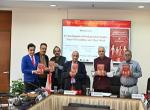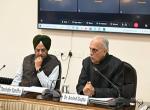The Islamic State (hereafter IS)/Islamic State of Iraq and Syria (ISIS)/Daesh is a transnational terrorist organisation which is based on the ideology of fundamentalism and Salafism teachings of Islam towards the creation and establishment of the Caliphate. From IS’s emergence in 2014 to its eclipse by the beginning of 2019, the IS remained a renowned terrorist organisation for its mass of foreign terrorist fighters from every corner of the world and its modus operandi. The ‘hunting down’ of IS’s self-declared leader and Caliph— Abu Bakr al-Baghdadi in October 2019 has certainly blurred the IS’s vision of 2020 Caliphate encompassing half of the world. However, the decentralisation of IS as an organisation raises a concern of lone-wolf attacks by sympathisers in their homeland. To understand the dynamics behind the emergence and fall-out of IS and its future, on 20th February 2020, the Vivekananda International Foundation (VIF) organised an interaction with Shri Mayank Sharma, the Principal Controller of Defence Accounts (Southern Command), Ministry of Defence, Govt. of India. The interaction was focused on IS terrorist organisation and further comprised of tracing the history or chronology of IS as an organisation, how it conceals the roots of international terrorism, how religious scriptures are misused to radicalise the young minds and a brief understanding of mobilisation of women as jihadi brides of IS fighters.
Shri Mayank Sharma (hereafter speaker) began the interaction with emphasising that any operation, even a military action, must have an objective. For example, as per the jihadists’ psychology, they are fighting to die in the name of religion or “Allah”. If they [jihadists] are ready to die in the fight for “Allah”, how a mighty military action can defeat them completely. This highlights that somewhere our approach to deal with the menace of terrorism is going wrong. He also highlighted the flow of foreign terrorist fighters who migrated from the well-educated western societies to the IS-controlled territories in Iraq and Syria.
As a popular thought, if the alienation and poverty are the factors behind the mobilisation of foreign terrorist fighters, then why did the mass-migration of IS fighters originate from European nations and not from Somalia. In his presentation, the speaker highlighted the places captured by the IS during its ascendancy and their mythological importance to the organisation. The IS uses the symbolic “black flag” due to a firm faith of Islam that during the apocalypse the Mahadi/Mahdi army will start the campaign from the Khurasan (ancient region comprises of Afghanistan and Pakistan) and the final battle place would be Dabiq in Syria. Dabiq was also the name of IS’s monthly magazine.
This shows that every action of IS had symbolic meanings related to religion. The main objective of the Islamic State is to establish the caliphate and end the Jahiliya or falsehood among the Muslim community. According to the speaker, the foundation of Islam is based on the destruction of Jahiliya. As per the IS, in modern times, if a Muslim is following Jahiliya then s/he deserves nothing but the death. Narrating the history of IS, the speaker talked about the lifetime of Abu Musab al-Zarqawi who was the founder of al-Qaeda in Iraq (AQI), the ups-and-down in the relationship between Zarqawi and al-Qaeda chief Osama bin Laden, and how he sowed the seed of modern-day IS terrorist organisation.
Later, AQI organisation was renamed ISI (Islamic State in Iraq) and after the death of Abu Musab al-Zarqawi, it was renamed as the IS or ISIS. In 2014, the IS took the opportunity and used the religion to create a massive wave of mobilisation of foreign terrorist fighters who were doing hijra or emigration to the IS-controlled territories as the establishment of Caliphate. The Muslims around the world answered the call of Abu Bakr al-Baghdadi because as per the Islamic rule, any Muslim who does not perform emigration is a Kufr or apostate. At the end, the speaker emphasised that although in late 2018 the caliphate was declared as defeated. However, it may have been defeated military-wise but as an ideology, it still exists.









Post new comment